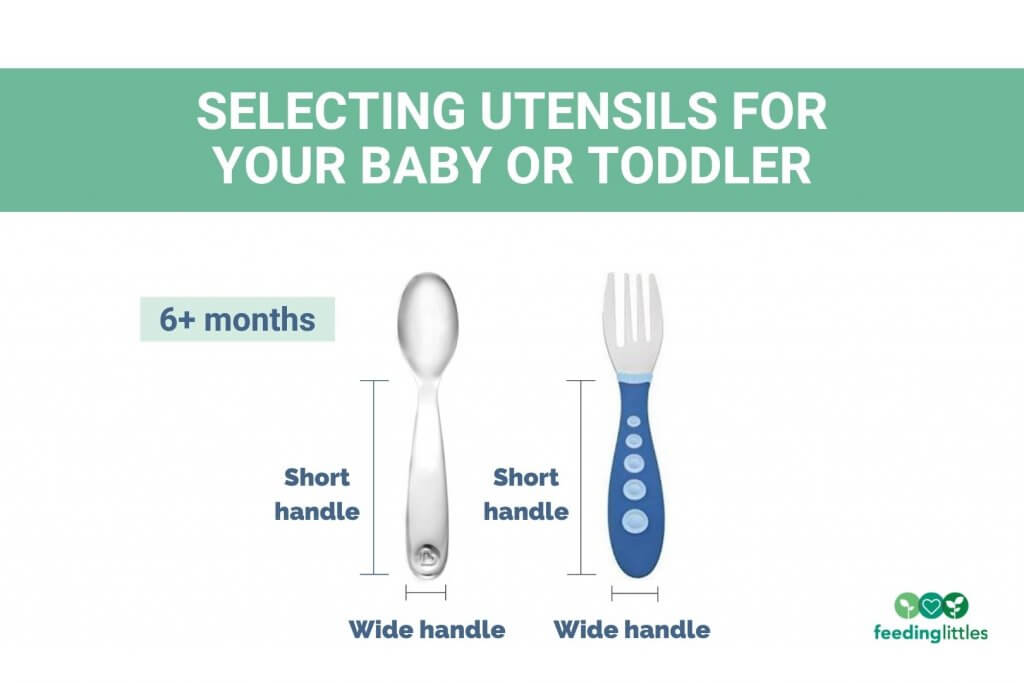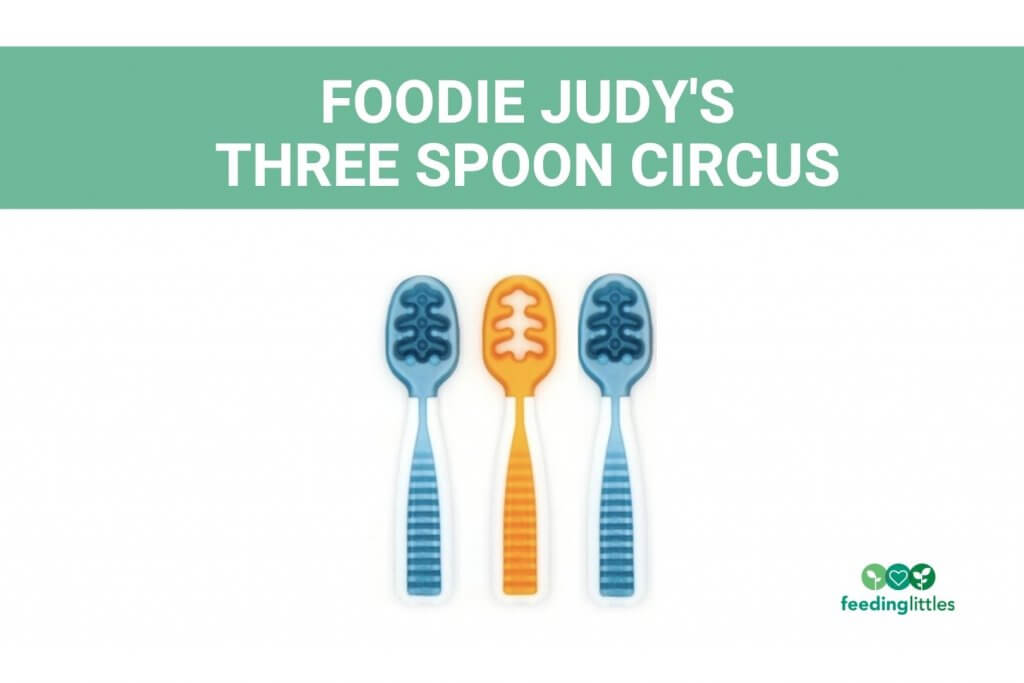Let’s talk about utensils! Read on for what to look for when choosing utensils for your baby or toddler, how to encourage them to use spoons and forks, and what to do if they are resistant or prefer their hands at every meal.

This post is all about helping kids use spoons, forks and eventually knives, but we recognize that not all cultures use these utensils.
Disclosure: some links below are affiliate links, which means (at no cost to you) we will make a small commission if you click through and make a purchase via Amazon. Check out our entire Amazon store here. We do not receive sponsorships by companies to promote specific products.
Which silverware to choose
Judy here! I am an OT Feeding Therapist, and one thing I emphasize with my clients who are looking for utensils for their baby is that it’s important to keep them small and keep it simple. You do not need to invest in a bunch of different types of spoons and forks, and interestingly, the products we recommend for infants can be used well into toddlerhood – there’s no need to have multiple types for multiple ages if you don’t want to.
When choosing silverware for your baby, look for short and wide handles. Short handles, or something less than 5 ½ inches in total length, are easier for a baby to maneuver. This means that the handle will be shorter than many traditional “infant” utensils. It should also mimic a real utensil in how it works. This encourages the appropriate motor skill as they learn to turn it toward their mouth by rotating their wrist.
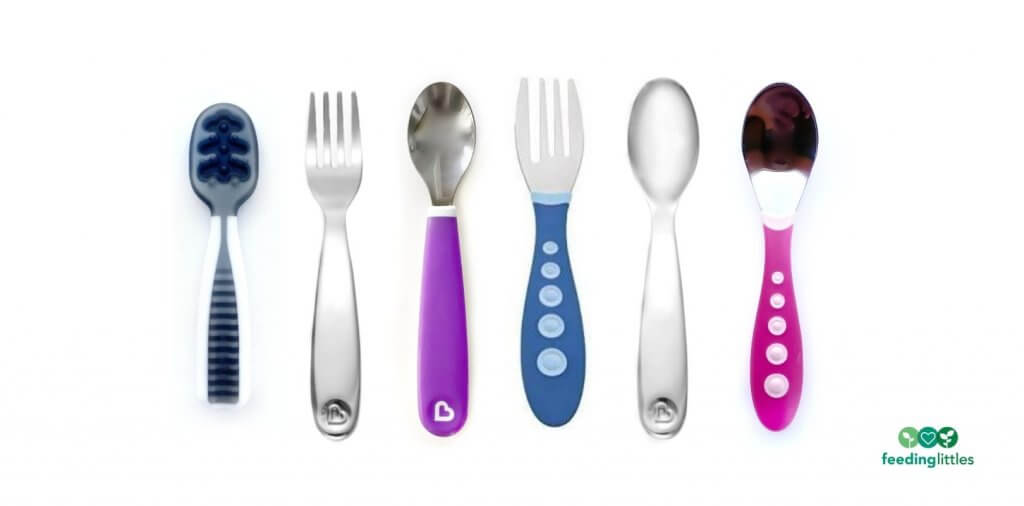
If you’re shopping for spoons, make sure the bowl of the spoon can hold enough food or has grip that food will stick to (like a NumNum GOOtensil) so all of the food doesn’t fall off before they get it to their mouth.
When deciding on forks, make sure the tines are rounded and not sharp, but are strong enough to hold on to food well when you preload it for your baby or toddler. Many silicone or plastic products don’t appropriately hold food on them, and this can cause motor frustration for your child! I use metal forks with almost all my infant clients. However, what matters most is your comfort level and knowing your child. Always supervise your kiddo with food, especially with utensils.
What about a choke guard? Some manufacturers use “choke guards” to prevent kids from pushing utensils too far back in their mouths. Unfortunately, these guards prevent kids from learning the confines of their mouth and “grading” how far back they should put the silverware.
I like NUK/Gerber Graduates Kiddy Cutlery, Num Num Inc. GOOtensils, Munchkin Polish Stainless Steel set and the Munchkin Splash set because they’re pretty easy to find, relatively inexpensive and can be used well into toddlerhood. Our Amazon shop is full of our favorite utensils!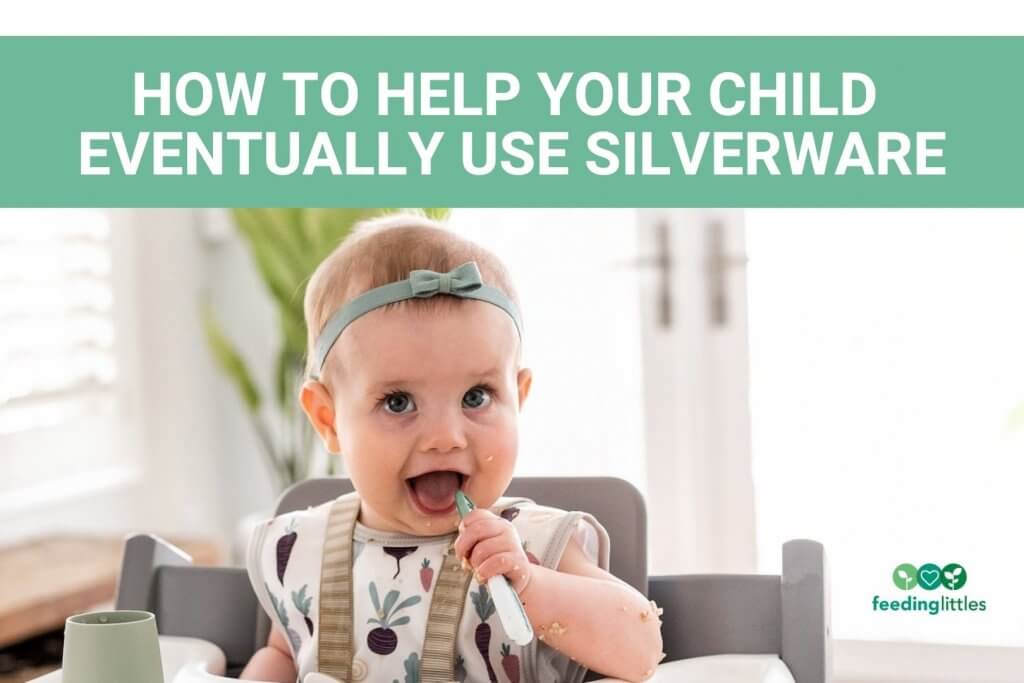
How do I help my child to eventually use silverware?
We recommend introducing loaded utensils around 6 months in our Infant Feeding course – yes, utensils are important in BLW or infant self-feeding! First and foremost, we want your baby to use their hands to feed themselves. That is most important. However, incorporating utensils right away is great practice.
Please remember – it’s not a race, it’s a process. We don’t expect most toddlers to independently scoop with a spoon or stab food with a fork until closer to 16-18 months if they have been practicing regularly. Loaded utensils are the first step – soon they’ll try to load them independently.
If they need more help, try the activities below and work with your provider.
6-12 months
Mealtime activities
- Let your baby get messy with food and offer food they can bring to their own mouth. Touching food is most important.
- Load spoons and rounded forks with food and hand them to your baby. Model using utensils when you eat. Model so they can imitate you, but don’t force it.
- Encourage development of the pincer grasp (and thus wrist rotation) by putting small pieces of food in an ice cube tray (8-12 months).
Playtime activities
- Play pat-a-cake, “so big” and peek-a-book to help your baby learn to use their hands and arms together
- Offer containers that baby can take toys/safe objects out of to help your baby learn to grasp and release objects
- Blow bubbles for your baby and demonstrate popping them by batting at them, clapping on them and poking with your index finger. This helps them develop timing and coordination.
12-18 months
Mealtime activities
- Model using utensils and offer them regularly. Your toddler may be 100% independent with utensils – or not. It’s OK if they pull food off a utensil to eat by hand or make a mess while practicing with utensils.
- Continue to offer pre-loaded utensils. Ask for the empty utensil back as you hand them a loaded one.
- Encourage your child to stack small pieces of food. This refines the pincer grasp and release needed for utensils.
Playtime activities
- Offer containers and shape sorters that your toddler can take toys in and out of – this practices a more refined grasp and release pattern than they had in infancy.
- Sit on the floor and roll a ball back and forth. This builds hand, elbow and shoulder strength and coordination.
- Model using your index finger to poke holes while playing with Play Doh. Poking skills promote the pincer grasp and more refined utensil skills.
18+ months
Mealtime activities
- Encourage your child to pour a sauce or dip from a small cup onto their plate. This promotes forearm rotation.
- Let your toddler serve food using a serving spoon or fork. This helps them practice with different size, shape and weight of utensils and gets them involved in the meal.
- Allow your toddler to safely pass small plates and bowls around the table. This promotes overall hand and forearm strength.
Playtime activities
- Coloring! Offer crayons and markers (if you’re brave!) to your toddler regularly to strengthen hand grasp and coordination.
- String large (not small) beads on to thick thread or laces. This is great for fine motor development.
- Practice stacking and knocking over blocks. (Two-year-olds are expected to be able to stack just two blocks.) This helps with coordination and timing.

What if my child always defaults to using their hands?
It’s completely normal for your baby or young toddler to default to their hands while learning to use utensils! Never force your child to use utensils. Touching food with their hands and messy exploration at mealtime is still SO important.
The biggest issue is – CAN they use utensils? Are they using their hands for other tasks even if they put down the fork at mealtime? Are they using their hands in their daily play? If the answer is yes, we generally don’t worry about utensil use as long as your child is *able* to use them and shows progression toward more coordinated use of their hands as they get older.
Make sure they’re also using their hands for many of their meals – involve utensils here and there so they have the opportunity to practice, but touching food and using their hands is super critical at this age.
Foodie Judy’s Three Spoon Circus
Have you noticed that if you let your baby or toddler feed themselves with loaded utensils they are likely to hold the spoon or fork hostage? How do you get it back from them without causing a battle?
One trick I use is my Three Spoon Circus, whereby you introduce a third loaded spoon {or fork} when practicing with utensils.
How does this work?
- Hand your child a spoon or fork loaded with food.
- After they eat off of the utensil, hand them a second loaded spoon or fork.
- This is the trick – introduce a third loaded utensil, especially if they are holding spoons one and two in their hands. Odds are, they’ll drop one to grab the new loaded utensil. By doing this, you’re “trading up!”
Without the struggle to pry the utensil from your child’s hands, mealtime stays more fun and positive and your child may be more likely to continue self-feeding! If you take away the spoon, make sure to offer a another loaded spoon.
My Three Spoon Circus can also be used with babies who are transitioning off of spoon-feeding. Sometimes parents are too nervous to offer finger foods, so letting their baby feed themselves purees can help them build confidence in the self-feeding process. Offer a small amount of purée on the spoon and hand it to baby to put in their own mouth.
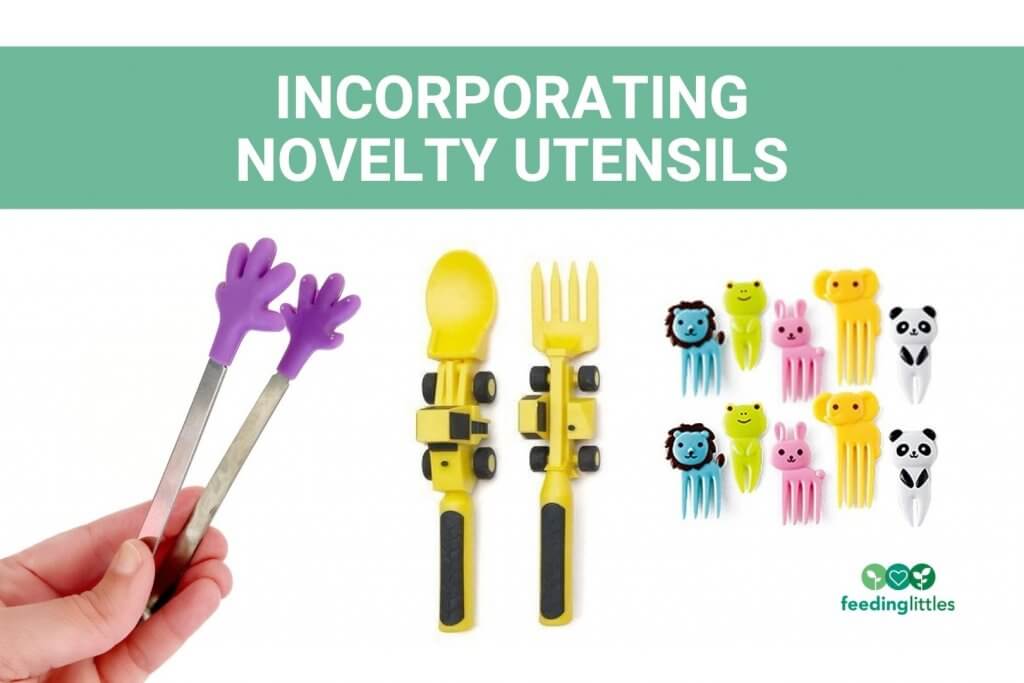
Incorporating novelty utensils
Is your toddler or older kid skilled at using utensils…but they’re also a selective eater? One simple technique we teach in our online Toddler Course is to bring out a unique utensil every so often.
Why does this work? Kids are drawn to novelty and new things. They want to master the world around them. It’s why they’re interested in the sample at the grocery store – it’s not the food itself, it’s the small cup and toothpick! Sometimes kids are more driven to play than they are to eat. When you combine play into the mealtime, like with fun utensils, you allow them to meet their developmental needs WHILE eating. Plus, it’s fun…and you’re more likely to relax and enjoy as well.
Of course, we don’t make kids eat the food – we simply offer these as a new way for them to interact with it. Even picking up the food is a win – one day they might actually eat it.
Our Amazon shop is full of fun novelty tools and ideas to spice up mealtime just a bit. You know your kiddo best – toothpicks or skewers might be tools you want to wait a bit to use. We recommend them no earlier than 2 years of age.
Remember, every kiddo is different, and mastering utensils takes lots of practice, patience and yes, even some mess. With time, your child will be a pro!
